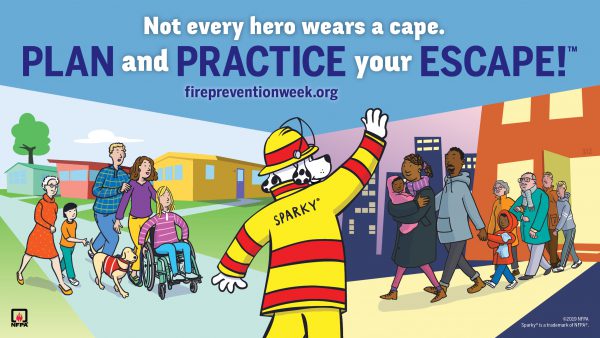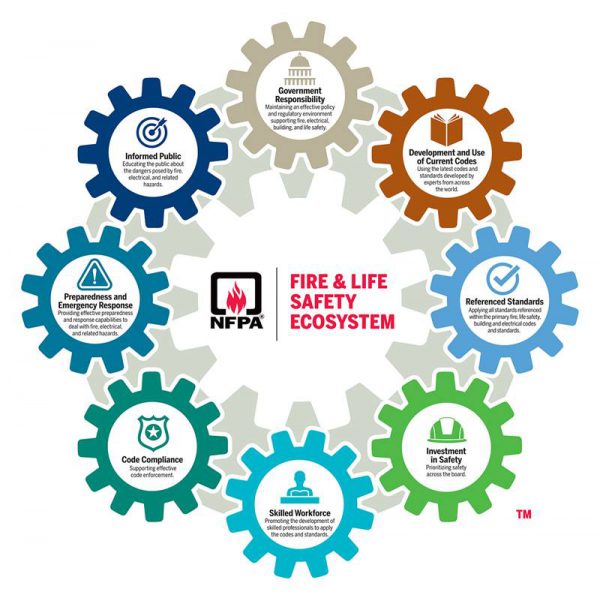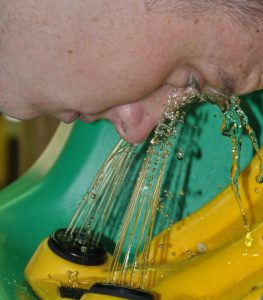-
March 17, 2020 by Total Fire and Safety

By now, most Americans are aware that you cannot contract the Coronavirus by drinking a Corona beer! We also know that the Coronavirus outbreak, that began in Wuhan, China, has spread across 27 countries including the United States. It is estimated that over 87,000 people are infected with the coronavirus or COVID-19 and numbers continue to climb. Much is unknown about the virus that causes COVID-19, but Doctors and scientists are drawing knowledge from similar coronaviruses and are working on a vaccine. What is the coronavirus and how can you as a business, keep employees healthy?
What is the Coronavirus(COVID-19)?
According to the CDC (Center for Disease Control), Coronaviruses are a large family of viruses that are common in humans and many different species of animals, including camels, cattle, cats, and bats. The virus that causes COVID-19 is spreading from human to human and causes with respiratory infections, like the common cold. The infection can become severe when it turns into pneumonia. One of the challenges to this virus is that symptoms may not show for two weeks, making it easy to spread.
What Can Employers do to Keep Employees Healthy?
The following is the CDC’s recommendation for businesses to create a healthy work environment.
1. Encourage sick employees to stay home. Employees should be fever free for 24 hours without the use of fever reducing medication. Stay flexible when it comes to sick leave, i.e., not requiring a healthcare provider note to stay off work. Provide job security and/or remote access when/if they need to stay home.
2. Encourage clean hands. Provide touch-free sanitizer dispensers, cleansing wipes, soap and water etc. Place informational posters throughout the workplace that encourage healthy precautions. Instruct employees to use hand sanitizers or wash hands with soap for at minimum 20 seconds.
3. Enforce Coughing Etiquette. Emphasize the need to cover mouths with arm when coughing or sneezing.
4. Quarantine sick employees. If employees come to work sick or become ill while at work, separate them from the rest of the population and send them home.
5. Sanitize touch points daily. Routinely clean doorknobs, buttons, switches, handles etc.(Any area frequently touched). Have readily available disposable wipes near commonly used surfaces.
6. Stress caution to employees traveling in or outside the country. If employees become ill while traveling, advise them to contact a healthcare provider immediately. Employees who show symptoms of illness prior to traveling should stay home.
A first aid kit can help!
A first aid kit should always be on hand for any business, but with a new virus in town, its value is even greater. Basic first aid kits contain items like pain relievers and fever reducers, antacids, and bandages to keep employees comfortable and on the job. Other items in a typical OSHA-required first aid kit can also come in handy to help employees fend off coronavirus:
Wound cleaning agents such as sealed moistened towelettes can be used to disinfect surfaces.
Latex gloves can come in handy to touch necessary items that may be infected
Resuscitation equipment such as resuscitation bag, airway, or pocket mask
Meanwhile, those with symptoms can make good use of other OTC supplies: Aspirin, Ibuprofen, Acetaminophen and Decongestants
Total Fire and Safety can assist your business in preparing for the coronavirus or any other emergency that may occur by servicing your first aid kit. Together we can fight this epidemic and keep one another healthy Give Total Fire and Safety a call today! (630)960-0560.
Category: Business Safety, Client Events, First Aid, First Aid Kits, Health and Safety Tags: commercial first aid kit, fire and safety needs, first aid, first aid supplies, lifesafety | Comments Off on Can You Protect Employees from the Coronavirus?
-
October 2, 2019 by Total Fire and Safety

Fire prevention week has been designated as October 6-12, 2019 by the National Fire Protection Association (NFPA). Fire prevention week has a long history, dating back to 1925, when President Calvin Coolidge proclaimed fire prevention week as a national observance. Now, it has become the longest running health observance in the country.
At Total Fire & Safety, we use this time to reiterate to our clients how important it is to stay compliant with NFPA codes and keep everyone within their buildings, warehouses and commercial spaces supplied with fire extinguishers, sprinklers, and suppression systems that are ready to go when fire strikes.
The theme of this year’s campaign is “Plan and Practice Your Escape.” So how can a business observe National Fire Prevention Week? Here’s a few ideas.
- Share safety information from the NFPA with your employees. Not only will it help them at work, but at home too!
- If you do not do so regularly, heed the theme of the program and “plan and practice your escape.” Every employee should be mindful of their best options in the event of an emergency.
- Call your fire protection service for an inspection of your equipment and make sure all your extinguishers, alarms, sprinkler systems, etc. are in working order.
- Consider a training class for fire extinguisher operation, first aid, or CPR.
Around the Total Fire & Safety service area, the observance is being commemorated with lots of events at community fire stations. For more information, see the website for each individual fire department.
Friday, Oct. 4
Saturday, Oct. 5
- Tinley Park Fire Department: 17355 68th Court, Tinley Park, 9 a.m. – 1 p.m. Open House
- Schaumburg Fire Department: 950 W. Schaumburg Road, Schaumburg, 11 a.m. – 2p.m. Public Safety Open House
- Clarendon Hills Fire Department: 316 Park Ave., Clarendon Hills, 11 a.m. – 2 p.m. Open House
- Minooka Fire Department: 7901 E. Minooka Road, Minooka, 11 a.m. – 2 p.m. Open House
- Hazel Crest Fire Department: 2903 W. 175th St., Hazel Crest, 9 a.m. – 12 p.m. Open House
- Frankfort Fire District: 20101 La Grange Road (Event address), Frankfort, IL 60423, 9:30 a.m. – 12:30 p.m. Gas Safety Event
- Palatine Fire Department: 39 E Colfax Street, Palatine, IL 60067, 10 a.m. – 2 p.m. Open House
- Darien-Woodridge Fire District: 7550 Lyman Ave., Darien, IL 60561, 10 a.m. – 1 p.m. Open House
- Oswego Fire Protection District: 3511 Woolley Road, Oswego, IL 60543, 11 a.m. – 3 p.m. Open House
- Calumet City Fire Department: 24 State Street, Calumet City, IL 60409, noon
Sunday, Oct. 6
- Belvidere Fire Department: 123 S. State Street, Belvidere, IL 61008, 1 – 4 p.m. Open House
- Mokena Fire Protection District: 19853 S. Wolf Road, Mokena, IL 60448, 7:30 a.m. – noon Open House
- Lake Zurich Fire Department: 321 South Buesching Road, Lake Zurich, IL 60047, 11 a.m. – 2 p.m. Open House
- Batavia Fire Department: 1400 Main St, Batavia, IL 60150, 11 a.m. – 3 p.m.
- McHenry Township Fire Protection District: 3610 W. Elm Street, District Administration Office, McHenry, IL 60050, 11 a.m. – 1 p.m.
- Naplate Fire Department: 2000 W Ottawa Ave, Naplate, IL 61350, 12 – 3 p.m.
- Manteno Community Fire Protection District, 13 S WALNUT ST, MANTENO, IL 60950, 12 – 3 p.m.
Monday, Oct. 7
- Western Springs Fire Dept: 4353 Wolf Road, Western Springs, IL 60558, 6 – 8:30 p.m. Open House
Wednesday, Oct. 9
- Lombard Fire Department: 50 E St Charles Road, Lombard, IL 60148, 6 – 8 p.m. Open House
- Downers Grove Fire Department: 6701 Main Street, Downers Grove, IL 60516, 6:30 – 8:30 p.m. Open House
Thursday, Oct. 10
Friday, Oct. 11
- South Chicago Heights Fire Department: 185 W Sauk Trail, South Chicago Heights, IL 60411, 5:30 – 7:30 p.m. Open House
Saturday, Oct. 12
- Northbrook Fire Department: 1840 Shermer Road, Northbrook, IL 60062, 9 a.m. – 12 p.m. Open House
- Crystal Lake Fire Rescue: 100 W Woodstock St, Crystal Lake, IL 60014, 9 a.m. – 12 p.m. Open House
- Prospect Heights: 10 E. Camp McDonald Rd, Prospect Heights, IL 60031, 9 a.m. Open House
- La Grange Park Fire Department: 447 N. Catherine Ave., La Grange Park, IL 60526, 10 a.m. – 1 p.m. Open House
- Elgin Fire Department: 650 Big Timber Road, Elgin, IL 60123, 10 a.m. – 3 p.m. Open House
- City of Rockford: 204 S. First St., Rockford, IL 61104, 10 a.m. – 1 p.m.
- Homewood Fire Department: 17950 Dixie Highway, HOMEWOOD, IL 60430, 11 a.m. to 2 p.m.
- Plainfield Fire Protection District: 23748 W. 135th Street, Plainfield, IL 60544, 11 a.m. – 2 p.m. Open House
- Westmont Fire Department: 6015 S. Cass Ave., Westmont, IL 60559, 11 a.m. – 3 p.m. Open House
- Alsip Fire Department: 11946 S. Laramie, Alsip, IL 60803, 1 – 3:30 p.m. Open House
- Calumet City Fire Department, Station 2: 1270 Pulaski Rd, Calumet City, 12 – 3 p.m. Open House
Sunday, Oct. 13
- North Palos Fire Protection District: 10629 S Roberts Rd, Palos Hills, IL 60465, 7 a.m. – 12 p.m.
- Byron Fire Department: 123 S. Franklin St., Byron, IL 61010, 11 a.m. – 3 p.m. Open House
- Elmhurst Fire Department: 601 S York, Elmhurst, IL 60126, 12 – 4 p.m. Open House
Wednesday, Oct. 23
- Chicago Ridge Fire Department: 10063 Virginia, Chicago Ridge, IL 60415, 6 – 9 p.m.
Fire protection and preparation is not just a week-long observance but a 365 day a year, 24/7 job. At Total Fire & Safety, we have everything you need to keep your employees and tenants protected. If we can ever assist your business with NFPA compliance for your commercial fire protection, contact us at 630-960-5060.
Category: Business Safety, Fire Equipment Inspections, Fire exits, Fire News, Fire Safety, Health and Safety, LED Lighting, NFPA Compliance, Total Fire and Safety Tags: commercial fire safety, emergency exit lights, fire and safety equipment, fire and safety needs, fire and safety solutions, fire safety in the news, lifesafety | Comments Off on 2019 Fire Prevention Week is for Businesses Too!
-
August 31, 2019 by Total Fire and Safety

Once again active shooting in public places is making headlines and making us consider our self defense options wherever we go. Unfortunately, our safety can be threatened almost anywhere, and self-defense is important. In your workplace or the facilities you manage, it’s important for the people inside to know how to react in the event of an active shooter or other attack.
In the case of an active shooter or other violent attack, potential victims have little or no advance warning. The sound of gunshots may be the earliest alert you receive, leaving little time to react. That’s why it is more important that you are prepared with a proactive plan of self defense, so you know how to respond immediately.
For years we were taught to shelter in place and wait for first responders. But studies have found that this line of defense results in increased casualties. Recently, offices and buildings have adopted the ALICE response plan. ALICE is an acronym for the five steps you can take to survive an active shooter attack. You may or may not use all the steps in the plan, but it’s nice to know that the fire extinguishers we regularly install and service, can actually be used effectively against an attacker in the “C” or “counter” step of ALICE.
So, in the event of an attack, remember ALICE:
- Alert- Let everyone in the office or the building know what is going on when you hear gunshots, receive a warning or phone message, etc. The faster you communicate, the more lives can be saved.
- Lockdown- If evacuation is not an option, lock the door, barricade it, and cover windows. Look for alternate escape routes, call 911, but do not open the door. Prepare yourself for the shooter to enter.
- Inform- Pass on as much information as you can. Who, what, where, when! The more those around you know, the better.
- Counter- Counter is one of the most dangerous but potential life saving strategies within the ALICE response. To counter is to fight back. Even in schools, there is one weapon, available to all, allowed and required in all buildings, and easy to use at your disposal against a predator. It’s your FIRE EXTINGUISHER!
While any object can become a weapon against the shooter, that five or ten-pound fire extinguisher on the wall can be very powerful. Remember that an armed assailant will not have a free hand to block counterattacks, nor will they be expecting one. Use your fire extinguisher to throw at the shooter or as a bludgeon when he comes through the door. Even if hitting him over the head does not knock him unconscious, it can buy you time to escape. You can also pull the pin and deploy the contents which can potentially blind or suffocate the shooter, or at the very least, startle him/her, long enough to disarm or tackle them.
To use a fire extinguisher, remember PASS:
- Pull the pin. Hold the extinguisher with the nozzle pointing away from you and release the locking mechanism.
- Aim low. Point the extinguisher at the base of the fire.
- Squeeze the lever slowly and evenly.
- Sweep the nozzle from side-to-side.
Once the can is empty, keep your grasp and ram the bottom of the can into the attacker’s face or body. Having training on how to correctly use a fire extinguisher ahead of time can ensure that your employees are prepared for more than fighting fires!
If you automatically locate the nearest escape doors when you go into a public place, it’s also a good time to note where the fire extinguishers are located, just in case.
The last letter in the ALICE acronym is “E.”
- Evacuate- Escaping the danger zone is always the best self defense option in the event of a shooter. Total Fire & Safety offers emergency evacuation and fire safety training so your people are trained to respond in a productive, organized way should an emergency ensue.
Total Fire and Safety is committed to all areas of life safety, including self defense against active shooters. For more information on our training, see our website or give us a call: 630-960-5060.
Category: Business Safety, Fire Extinguishers, Fire Extinguishers, Fire Safety, Health and Safety Tags: employee training, fire and safety equipment, Fire Extinguisher, fireextinguisher, Fireextinguishertraining, firesafetytraining, lifesafety, safety, Self Defense, Total Fire and Safety | Comments Off on When Self Defense Meets Fire Safety
-
February 27, 2019 by Total Fire and Safety
 Image: NFPA Website The fire and life safety ecosystem led the discussion at the 2018 NFPA Conference and Expo. What is the fire and life safety ecosystem? Like any ecosystem, it is comprised of elements that work together to achieve a functioning system—in this case, eight separate elements that have to do with fire and safety. Several of them are the responsibility of the government, while many call upon the public to enforce and deliver. Regardless of who is charged with the responsibility, the goal throughout the ecosystem is to prevent major disasters from fire, electrical, and other hazards. When tragedies occur, it is likely there was a breakdown in one or more parts of the fire and life safety ecosystem. Here are the eight components relating to the fire and life safety code:
- Government Responsibility: Policy makers must maintain effective policy and regulatory environment and not prioritize politics over the public’s safety. When life safety codes are stripped for any reason, people’s lives are endangered for the sake of political gain.
- Development and Use of Current Codes: Government and building designers must implement the latest codes and standards or risk losing the latest technology and research in fire, electrical, life safety.
- Referenced Standards: All standards within the fire, life, building, safety, and electrical codes must be addressed or the right products and practices will not be used, possibly leading to disastrous results.
- Investment in Safety: Property managers and need to make an investment in safety to comply with the latest standards and codes. Hiring a company like Total Fire and Safety means an investment in safety. All the latest fire safety technologies are always available from TFS and we can design a program to fit any company’s needs and budget.
- Skilled Workforce: Promote the development of skilled professionals to apply the codes and standards. For over 20 years, TFS has employed highly skilled, highly trained, and highly dedicated workers in order to put customers’ safety above all else.
- Code Compliance: Effective code enforcement is necessary. Fire Marshalls and other officers must conduct regular inspections to ensure safety and code compliance.
- Preparedness and Emergency Response: Provide effective preparedness and emergency response capabilities to deal with fire, electrical, and related hazards. Train employees on emergency equipment, fire safety drills, designated leader in emergencies, etc.. TFS provides training classes for employees, as well as, informative literature on how to react in an emergency and much more.
- Informed Public: Educating the public is important, as is educating businesses about the specific fire hazards in their facilities.
No one cog in the fire and life safety ecosystem can keep us all safe from harm. Even all the pieces together, working in tandem, may not prevent every disaster, but they can certainly prevent many. By practicing and implementing the various areas outlined in the fire and life safety ecosystem, we can all create a safer community. At Total Fire and Safety, we are committed to helping you play your role in the fire and life safety ecosystem. Contact us today to discuss your fire safety needs or call 630-960-5060.
Category: Business Safety, Fire code violation, Fire Safety, Health and Safety, NFPA Compliance, Total Fire and Safety Tags: fire and safety equipment, fire and safety needs, fire and safety solutions, fire safety solution, fire safety training, Total Fire and Safety | Comments Off on What’s a Fire and Life Safety Ecosystem?
-
March 15, 2018 by Total Fire and Safety
 Nobody thinks much about emergency exit lights. But if the power suddenly goes out, smoke fills the room and you can’t see a foot in front of you, relying on the emergency lights may be your only means of escape. Nobody thinks much about emergency exit lights. But if the power suddenly goes out, smoke fills the room and you can’t see a foot in front of you, relying on the emergency lights may be your only means of escape.
Emergency exit lights are essential to safety in any dangerous situation. They can alarm someone in a fire, be the only source of light in the dark, and the key to safely exiting the building. Emergency exit lights are often overlooked and taken for granted, but take note of how many you come across every day. Do you realize how many requirements and regulations go into the installation and maintenance of one exit sign?
There are numerous agencies that govern emergency exit lighting and signs: OSHA (Occupational Safety and Health Administration), NFPA (National Fire Protection Administration, JCAHO (Joint Commission on Accreditation of Healthcare Organizations and the International Building Code and International Fire Code. Above all these agencies, the local authority is responsible for monitoring and enforcing building/fire codes.
According to OSHA, an exit route is defined as a continuous and unobstructed path of exit travel from any point within a workplace to a place of safety. There are three parts to an exit route:
- Exit access-part of the exit route that leads to an exit.
- Exit-part of the exit route that is separated from other areas and provides a safe means of travel to exit discharge.
- Exit discharge-part of the exit route that leads to directly outside or refuge area.
OSHA’s requirements for the lighting of these afore mentioned exit routes is covered under 1910.37(b). It states that each exit route must be sufficiently lighted so an employee with normal vision can see along the exit route and each exit must be clearly visible and marked by a sign reading “EXIT.” Additional information for OSHA requirements can be found at www.osha.gov.
The NFPA guidance for emergency exit lighting and signs can be found in the NFPA 101, Life Safety Code. The NFPA’s Life Safety Code provides information for placement, illumination, and visibility for exit signs.
- Placement of exit sign. Any exit signs must be located so that no point in an exit access area is more than the sign’s viewing distance, or 100 feet from the nearest sign.
- Visibility of exit signs-Every sign must be located and of such size, distinctive color and design that is visible and contrasts from the background of its placement. NFPA also states no decorations, furnishings, or equipment that impairs visibility of a sign shall be permitted. Nothing should be placed near an exit sign that distracts attention and inhibits visibility of an exit sign.
- Illumination of Exit Signs-The NFPA states all exit signs must be illuminated by a reliable light source and legible in normal and emergency exit lighting modes. There are two categories of illumination: external illumination, which comes from outside the exit sign and internal illumination, which comes from a source inside an exit sign.
According to the NFPA, emergency illumination must be provided for a minimum of 1.5 hours in the event of power outage. The emergency lighting must be illuminated not less than an average of one lumen per square foot. The maximum illumination at any point can be 40 times the minimum illumination. All emergency exit lighting must be able to provide lighting automatically when normal light is interrupted.
Many emergency exit lights are now using LED lights. The NFPA states that LED lights are longer lasting, provide better light and are most durable. In emergency situations, LED lights emit sufficient lighting and are most effective when placed properly. They are also most energy efficient, saving the building money.
According to the NFPA requirements for testing, there are three categories of emergency lights: traditional, self-testing, and computer base self-testing. A monthly activation test which involves having the lights illuminate for no less than 30 seconds and an annual test which keeps the lights illuminated for 1.5 hours, simulating a long-term emergency. Records of these test must be maintained for inspection.
Many regulations, codes, and considerations go into the signs and lights you see every day so it is important to have regular maintenance and testing of these lights. Total Fire and Safety has a knowledge team for inspecting emergency exit lighting. With regular maintenance and testing from Total Fire and Safety, you can be assured your emergency exit lighting is up to code and the safety of your employees/tenants is assured. Give us a call today 630-960-5060.
Category: Business Safety, Fire code violation, Fire Equipment Inspections, Fire exits, Fire News, Fire Safety, Health and Safety, LED Lighting, NFPA Compliance, Total Experience, Total Fire and Safety Tags: commercial fire protection, commercial fire safety, emergency exit lights, emergency lighting, fire and safety equipment, fire and safety needs, fire and safety solutions, fire safety in the news, fire safety solution, fire safety training, lifesafety, safety | Comments Off on Are You In the Dark About Emergency Exit Lights?
-
December 19, 2017 by Total Fire and Safety
 If you have hazardous chemicals onsite, you likely need an emergency eyewash station. One of the many vital services we provide at Total Fire and Safety is performing inspections on emergency showers and eye wash stations. Like any fire or safety equipment, routine inspections are a must to ensure your equipment will perform perfectly at a moment’s notice. In an emergency situation, nobody has the time troubleshoot an underperforming piece of equipment, let alone attempt to repair it. We’ve outlined the steps we take to ensure your eye wash station or emergency shower is ready in an emergency:
1. Ensure everything about the station’s location is correct. We first make sure the station is in an area it is needed. A working emergency eye wash station is of no use if it is not accessible to those who may need it. While showers tend to be fixed structures, eye wash stations can be either fixed or mobile. We also make sure the station is unobstructed and away from any source of debris or hazardous spray, which could compromise its usefulness.
2. Next, we inspect the exterior. We visually check every part of the station for any signs of damage, such as leaks, cracks, or other signs. Then, we check that all the hardware is intact and correctly in place, such as the caps, valves, and pull rods for showers. We then verify everything is at the correct height and that all signage is in its proper place before moving on to the next step.
3. After the visual inspection, we test the operation. For every eye wash station, we check the flow of water by gauging its height, volume, and response time from the moment of activation. For showers, we verify the water flows properly and onto the correct area.
4. For portable units, we empty and replace the water. This is to ensure the water in the reservoir is not only full, but clean and fresh. This step is also taken so that we can rinse out the inside as well as check for foreign debris or contaminants which could compromise the integrity of the eye wash station.
5. Finally, we clean everything and document the inspection. This entails wiping everything down with a rag and cleaning solution. Once this is done, we apply the inspection tag to the station to communicate to others when the inspection took place and what was performed. We also keep our own records of the inspection by filling out detailed information in an eyewash report.
In any facility that may contain hazardous substances, you may find an emergency shower or eye wash station idly waiting until needed. These units are not given much thought, but anyone who has ever used one in an emergency situation will vouch for its importance to stay in proper working order. If you have any questions or concerns about your emergency eye wash station or shower, or about the readiness of any of your fire safety equipment, please contact us.
Category: First Aid, Health and Safety, NFPA Compliance, Total Fire and Safety, Uncategorized Tags: fire and safety equipment, first aid, first aid supplies, Health and Safety, Total Fire & Safety | Comments Off on Are Your Emergency Eye Wash Stations Ready for Action?
|

|
|
|
|
|
|

 Facebook
Facebook
 Instagram
Instagram
 LinkedIn
LinkedIn



 Nobody thinks much about
Nobody thinks much about 
